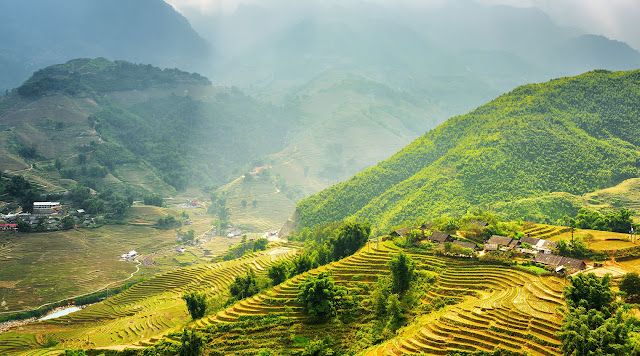Banh Khao
Banh khao is one of the very famous specialties of Cao Bang. The main ingredients are glutinous rice, sugar, peanuts, and sesame. When you bite into a piece of banh khao, the sweetness of the sugar, the buttery taste of peanuts and sesame, and the soft glutinous rice cake combine to make a delicious dessert snack that will not fill you up. The final product is wrapped in colored paper in rectangular shapes.Banh khao is usually made for Tet (Vietnamese New Year). A custom of Cao Bang says that as long as banh khao is in a local home, it is still Tet vacation. However, you can buy banh khao at any stores in Cao Bang.
Pho Chua
The unique sour noodle is the highlight of Cao Bang culinary. A bowl of Pho Chua is abundant, filled with fleshy liver meat, bacon, roasted duck, heap of peanuts and chili. In summer time, the sauce is made with a light sour taste, making it even delicious. This dish can be eaten for any meal of the day.Banh Trung Kien
In April and May of every year, the Tay ethnic group of Cao Bang Province gathers at the forest to find the black ant-eggs which are major ingredients to make the cake. “Banh Trung Kien” is made from the glutinous rice flour, ant-eggs, and the young leaves of fig tree. The black ant-eggs in Cao Bang are high in protein. Understand that not every kind of ant-eggs can be eaten, and only the Tay people know how to sort out those of the right black ant-eggs (the ants with small body and pointed tail).Secrets might also lie in the steps of mixing the glutinous rice flour, the flour grinding, the ant-eggs frying, etc. The completion should be steamed and then left cool to be cut into the square pieces. The cakes are soft, fragrant with the fig leaves, fatty and scrumptious thanks to the high-protein ant-eggs.
Vit Quay Bay Vi
Vit quay bay vi literally means roasted duck with seven flavors. Before roasting the duck, the cook marinates it with seven ingredients including ginger, garlic, shallots, peppers, honey, tofu, and a special ingredient which is Clausena indica, a fruit grown in Cao Bang’s forest.After roasting, the duck is cut into small slices and put on a plate. When eating vit quay bay vi, you should chew slowly to experience the seven flavors of this dish. Try to guess the ingredients as most people do when trying this food for the first time. When travelers return home and try to cook it, they say it never has the same taste as it did in Cao Bang. The reason is the absence of Clausena indica, which only grows in Cao Bang.
Banh Coong Phu
The best time to eat banh coong phu is in the winter. A vendor will put banh coong phu in boiled water and wait until the pieces float to the surface. She will then put them to a bowl and pour in the sugar water. Hot banh coong phu will warm you up and the sugar provides much-needed energy to fight against the cold of this high land.
Banh Che Lam
The list of the unique delicious Cao Bang food cannot miss, “Banh Che Lam” which is made from the roasted sticky rice, roasted peanuts, ginger, and malt. The cake brings the enjoyable eating experiences in which foodies appreciate the sticky sweet honey, the soft sticky rice, the ginger taste, and the scrumptious peanut. All makes this cake unforgettable. Served with the hot tea, this traditional cake makes guests fall in love with the green charming land. The cakes are on sales in local markets and shops.Read more: The unique experiences in Sapa, Vietnam
Source Internet












